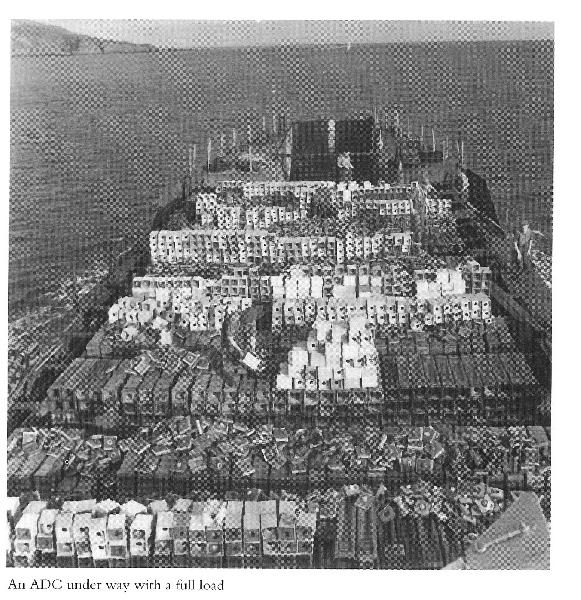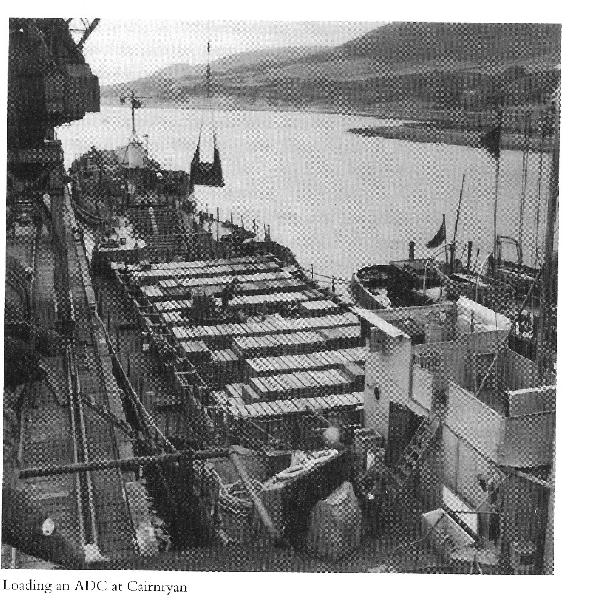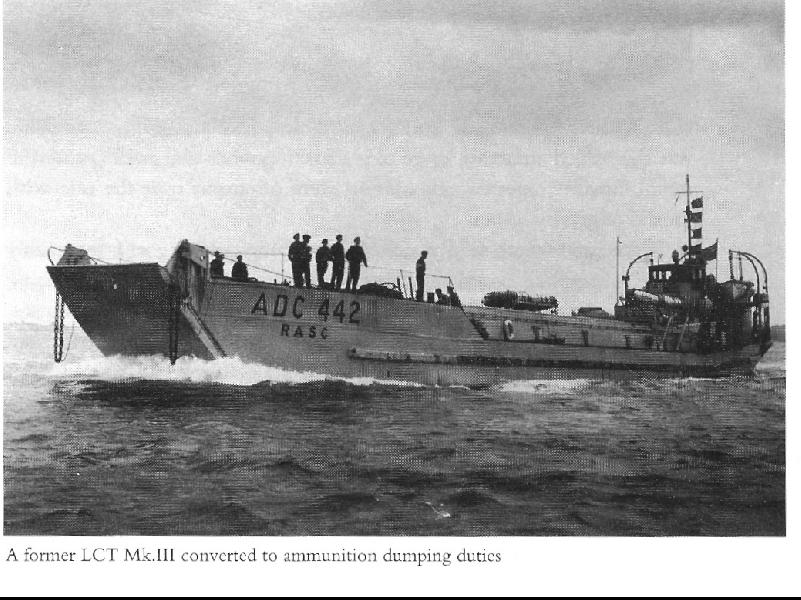


A recent spate of incidents in which munitions were washed ashore has once again focused attention on the legacy of munitions dumping by the British government at a number of
A recent spate of incidents in which munitions were washed ashore has once again focused attention on the legacy of munitions dumping by the British government at a number of coastal (and deep sea) locations around the British Isles.
Undoubtedly the largest concentration of dumped ordnance was deposited in the Beaufort Dyke and includes, explosives, chemical weapons and even quantities of nuclear material.
The Celtic League have been carrying out further research into the Beaufort Dyke dumping saga and we have uncovered previously little publicised information about the extent of the operation and also photographs which convey the staggering scale of the munitions dumped.
Beaufort Dyke had been a favoured dumping location for the military since just after World War One (WW1). Given the sensitivity about the marine environment today it seems a strange location to choose. It lies just off-shore in the north channel between Northern Ireland and S W Scotland close enough for contaminated material to be carried onto shorelines around the Irish sea. The Dyke covers an area of about 20 miles long by 10 miles wide however the original sits for disposal was a deep section at its centre 7 by 2 miles in dimension and about 150 fathoms deep.
Its attraction to the military was that its was close to accessible ports with road and rail communication and being a natural deepwater trench was considered (wrongly) a safe site for permanent disposal.
After WW1 both explosives and mustard gas was dumped and this latter material \'Yperite\' named after the battle at Ypres where the gas was first used was to feature almost fifty years later in the most serious documented incident of chemical weapons contamination when a Breton fishing vessel crew were contaminated (see below).
After World War Two Dumping of material at Beaufort Dyke commenced in earnest and a vast fleet of military vessels (manned by civilians) but administered by the British Army\'s Royal Army Service Corps (RASC) operated for various bases in North Wales, Lancashire but mainly from Cairnryan in S W Scotland.
During the main explosive dumping period from 1945-1960 up to 24 Tank Landing Craft (LCTs) euphemistically called Ammunition Disposal Craft (ADCs) were used together four coasters and a number of ex-trawlers to provide support in the Beaufort Dyke operation. In addition larger vessels were used several of which several were scuttled with cargoes of chemical weapons in deep water to the West of Scotland and off Donegal. On occasion cargoes destined for deep water disposal were diverted to Beaufort Dyke because of bad weather
The ADCs used at Beaufort varied in tonnage carried there were three types of LCT the Mk 111, Mk 1V and Mk 1V . The Mk 111 was the larger 200ft by 30ft and could carry over 300 tons of ordnance.
Dumping operations were carried out by lowering the forward ramp on the LCT and going astern with large munitions (in some instances up to 5 ton bombs) simply rolled over the ramp. Smaller munitions were discharged over the side with the aid of gravity rollers. (The illustrations which we hope to use when this article is posted on our parallel site at ABP will show the quantity and variety of the munitions disposed.)
Weather always posed problems. Conditions, particularly in winter, in the north channel are unpredictable and missions had to be completed in haste - many munitions were dumped outside the designated dump site as a consequence.
This was a massive operation originally in the years immediately after WW2 utilising captured Italian and German prisoners of war as labour in Cairnryan Port.
Subsequently regular army logistics personnel from the Royal Pioneer Corp troops were used and in one phase of the operation, involving the transfer of aircraft bombs both explosives and gas from dumps in North Wales, RAF personnel were used.
The dumping was not without incident. In once instance rocket projectiles cased in wooden boxes were dumped and washed ashore. Subsequently Pioneer Corps personnel were issued with crowbars to make holes in the wooden boxes so they would sink more readily in an accident on the pier at Cairnryan a complete trainload exploded as a result of this box piercing. Another accident involved a US ammunition vessel which caught fire.
Several personnel were killed during the dumping. One ADC disappeared of the North of the Isle of Man whilst another, attempting to shelter in a storm, was refused entry to Ramsey (IOM) when harbour authorities realised the dangers posed by its cargo. It had to ride out the storm for several days
More than a million tons of explosives passed through Cairnryan destined for Beaufort Dyke.
As late as 1955 coasters were still bringing cargoes of munitions from dumps in Normandy in France to be disposed of in the north channel and disposals of munitions did not cease entirely until the early 1980s.
The result is a dangerous and enduring legacy for future generations in the coastal communities around the north Irish sea.
THE DANGERS OF BEAUFORT DYKE - The story of the impact on one Breton fishing vessel crew forty years ago:
The late Angela Kneale who acted as Consul for the Government of France on the Isle of Man documented (in her book FISH & SHIPS) one of the most dramatic accounts of contamination by chemical weapons of civilians, It involved the crew of the Breton trawler Aquilon and is set out below:
`Mid-July 1969, the Aquilon put into Peel one evening without warning. The skipper, Michel Poédras, phoned from a call-box.
\"Six of my men are suffering from blisters and itching, specially on the hands. No other symptoms.\"
\"I\'ll order two taxis for you in Peel and meet you at the hospital.\" I found five of them plus the skipper waiting for me.
\"Where is the sixth man?\"
\"He refused to come. He says he once promised his Granny never to set foot in a hospital, because according to her you only go there to die.\"
Dr Rhoda Johnson was on duty. She asked endless questions about their meals, suspecting food poisoning, but as they all ate the same fare, why were only some of them affected? Her investigations proved negative. She consulted a colleague without success. She had no explanation for the ugly blisters which would burst and re-form before our very eyes. She pre scribed some ointment and other medication I cannot recall, and they returned to sea.
Two days later they were back. The condition of two of the men had worsened, specially in the genital and lower abdomen area; the others were improving slowly. We met again in hospital, but this time Dr Johnson asked Dr Tom Hardy, a dermatologist, to come in from Ramsey to have a look at them. While tests were being carried out on the two aggravated cases, I overheard an interesting conversation between the other men.
\"1 tell you, it\'s the stuff we fished. It all started after that.\"
\"That\'s what I\'ve been thinking.\"
\"But we mustn\'t let on. . . We were not supposed to fish there, the mate says he saw it clearly marked on the charts.\"
\"And we don\'t want to be dragged through court like the two poor beg gars last week.\" This was a reference to two French skippers who had been severely dealt with in Peel Court for alleged `illegal\' fishing. They eyed me surreptitiously. I pretended to be engrossed in a woman\'s magazine.
\"Wasn\'t it awful! The stench! Like a million rotten eggs, only worse.
\"And that oozy black-and-yellow stuff, yucks! I could throw up when I think of it. . \"And such a fine haul, too! Broke my heart having to shovel it back over the side. I had visions of putting a new roof on my garage with the pro ceeds . . .\" I closed the magazine and gave a little cough to draw their attention:
\"I couldn\'t help overhearing you. What `stuff\' did you fish? And where? And exactly when?\" Embarrassed silence. Exchange of glances.
\"Don\'t think the skipper would be too pleased if we tell you.\"
\"Now don\'t be daft! Two of your mates are in a very bad way; your turn may be next. Unless the doctors know the cause, they\'ll never find the right treatment.\"
\"Will the skipper be arrested if they know where we were working?\"
\"It depends on the position, but I shouldn\'t think so. Normally the Royal Navy takes a fix on the spot. I doubt very much, the condition you\'re in, that illegal fishing would be given precedence over health hazards. Was it close to a coast?\" I was thinking of Calder Hall, later known as Windscale, then re-christened Sellafield.
\"No, don\'t think it was even within the twelve mile limit.\"
\"Well then, how could it have been `illegal\'?\"
\"Because on the charts it says `Munitions dumping area - No fishing\'. It\'s between the Isle of Man and Scotland.\"
\"Now we\'re getting somewhere. Please tell me what happened.\" They all started at once, but eventually one chap emerged as the best spokesman, intelligent and to the point:
\"We were hauling. The trawl was very full, it felt heavy. We lifted the bag and as soon as it came out of the water there was an incredible stench and our eyes began to smart. We emptied the catch on deck, a huge haul, but stinking and all mixed up with a yellow oily substance streaked with black. We had to throw the lot overboard. Then we hosed down the deck repeatedly till the last trace of the muck was gone. Our eyes were smart ing all the while and soon after we started developing blisters on our wrists, hands, face and neck. The two who are being examined now are the only ones who got it on their bodies. All those who had been on deck were affected, not the others.\"
I reported immediately to doctors Hardy and Johnson. It later turned out to have been mustard gas from the First World War, called `Ypérite\' in French after the town of Ypres in Belgium where it was first used. A can ister had come up in the trawl, was crushed by the weight of fish, and its contents were spilt. Simple, once you knew..
The two worst affected men presumably urinated at some point and con taminated their genital parts and lower belly. One of them, Christian Corvec, improved sufficiently to go home after two weeks of treatment, but the other, Eugene Jego, was allergic to penicillin, of which he had been given massive hourly doses. He swelled up like a balloon, turned purple and shed all his skin including his scalp. He looked like a rather soiled snowman. The last of the skin to peel off was that of his hands, the palms and fingers being so grossly calloused. The soles of his `new feet\' were so tender that he could not wear shoes, only slippers.\'
Source: FISH & SHIPS by Angela Kneale ISBN 1 873120 19 2 Publisher: The Manx Experience
J B Moffatt Director of Information Celtic League
18/04/09

Commentaires (0)
Aucun commentaire pour le moment. Soyez le premier à réagir !